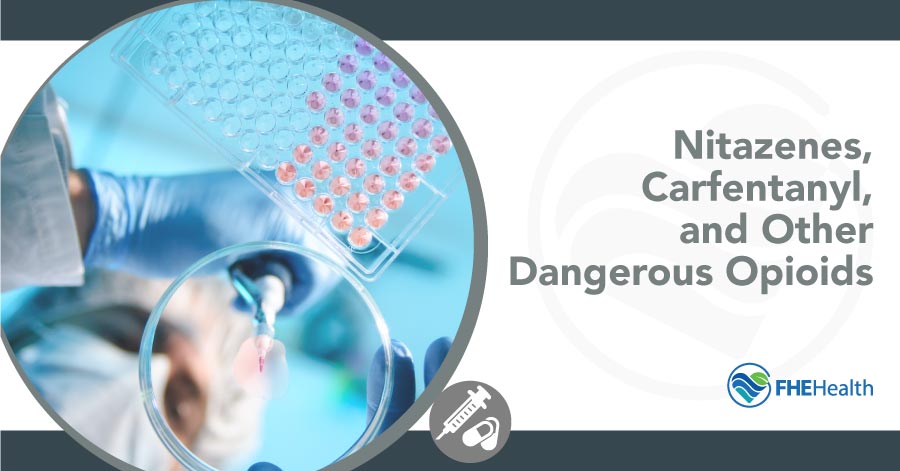
Once the most addictive and dangerous opioid,, heroin has since been eclipsed by several synthetic opioids that are 40 to 100 times more potent. Adding to the increasing number of synthetic opioid overdoses and deaths is what the U.S. Drug Enforcement Administration deems “an alarming increase in the availability and lethality of fake pills containing methamphetamine and fentanyl”.
Easily bought on the Dark Web, on social media, or on the street, these counterfeit pills are not only illegal but, in some cases, lethal. According to a recent warning from the U.S. DEA, over nine million counterfeit pills were seized by DEA agents and law enforcement in 2020. Many of these fake pills contained deadly amounts of fentanyl laced with methamphetamine or other harmful stimulants.
One Pill Can Kill
In response to the massive influx of fake prescription pills pouring into U.S. communities, the DEA recently launched a public education campaign called “One Pill Cn Kill.” Information that the DEA wants the public to be fully aware of :
- Counterfeit pills look similar to prescription opioids such as Vicodin, Oxycontin, Xanax, and Percocet. Never purchase pills from someone claiming they are real prescription pills. Opioids should only be prescribed by a physician licensed to provide opioids for treatment of health issues.
- Fake prescription pills are even available on e-commerce websites that appear legitimate. These sites typically claim their pills are legal to buy in the U.S. because they are not regulated by the U.S. FDA. Since anyone with a cell phone can access counterfeit pill websites, minors can easily buy these “one pill can kill” drugs.
- Most fake opioid pills are made in Mexico, but some are produced in the U.S. for the purpose of expanding traffickers’ markets. Fentanyl is used by drug cartels because it is simple to make, easy to transport illegally, and highly profitable.
What are the Most Dangerous Opioids Fueling the Drug Epidemic in the U.S.?
Fentanyl
Fentanyl (street name “China Girl,” “Tango & Cash,” “Goodfellas”) is an anesthetic, analgesic synthetic opioid that is 50 times more potent than heroin and 100 times more potent than morphine. Available by prescription only in the form of sublingual tablets (Abstral), lozenges (Actiq “lollipops”), and transdermal patches (Duragesic), fentanyl is snorted, injected, taken orally as a pill, or smoked by drug addicts. The CDC estimates that at least 150 people die in the U.S. every day from overdosing on a synthetic opioid like fentanyl. Nearly 42,000 people between 18 and 45 died from a fentanyl overdose in 2021. Experts expect that number to rise even higher in 2022.
Nitazenes (“Frankenstein Opioids”)
Nitazenes (benzimidazole opioids) are a class of synthetic opioids first developed in the 1950s as an analgesic medication. Analogs of nitazenes include etonitazene, butonitazine, and metonitazine. Undocumented nitazenes are now being found in blood and urine samples of individuals suspected of overdosing on synthetic opioids. First appearing in 2019 as a major factor in Canadian and European opioid overdoses, nitazenes are considered one of many emerging synthetic opioids known for their high abuse potential and risk of severe respiratory depression leading to death.
Nitazenes are 20 times more potent than fentanyl. Due to their potency, a normal dose of Narcan may not reverse the effects of an overdose caused by ingestion of nitazenes. Limited research on why nitazenes are more powerful than other synthetic opioids indicates these drugs induce unusually high activity at specific opioid receptors in the brain. In 2020, the DEA added nitazenes to the list of Schedule I controlled substances.
Carfentanil
Developed specifically to tranquilize large animals like elephants and giraffes, carfentanil is over 100 times more potent than fentanyl and 10,000 times more potent than morphine. In fact, carfentanil’s lethality is so extreme that just inhaling or touching a small amount could cause symptoms of overdose. Experts warn that multiple doses of Narcan may not reverse an overdose of carfentanil.
Illegally bought carfentanil looks like powdered cocaine and is typically snorted or injected. One mg of carfentanil is equivalent to approximately 10 g of morphine. Symptoms of a carfentanil overdose are disturbing and demand immediate attention by an emergency doctor. They include gurgling noises as the overdose victim is trying to breathe, blue lips and tongue, disorientation, seizure-like body movements, and unconsciousness.
Isotonitazene (ISO)
Derived from a nitazene called etonitazene, ISO is 60 times more potent than morphine. Intended only for forensic and research purposes, ISO is a Schedule I controlled substance with high abuse potential.
Drug cartels obtain ISO from China-based manufacturers who advertise on the Dark Web. Primarily used to make fake Oxycontin and Valium pills, ISO is a preferred ingredient (along with fentanyl) due to its accessibility and ease of combining with other ingredients. Inhaling ISO or allowing ISO to come in contact with skin can cause symptoms of an overdose. Cartels sell bulk quantities of ISO as a white, yellow, or brown powder to makers of fake prescription pills.
ISO has mostly been found throughout Florida and is associated with drug overdose deaths among students on spring break. Florida Attorney General Ashley Moody has since issued several warnings about ISO to vacationing students as well as all Florida residents. “Please be aware that ISO can kill you if you accidentally inhale or come in skin contact with ISO,” Moody stated. “Be aware that just one pill, can kill”
Synthetic Opioids
A synthetic opioid is a drug created in a laboratory that has the same powerfully sedative effects provided by pharmaceutical opioids. The difference between pharmaceutical opioids and synthetic opioids involves the use of chemicals derived from the poppy plant. Pharmaceutical opioids, like morphine and codeine, contain alkaloid compounds taken directly from opium poppy plants.
Alternately, synthetic opioids, like fentanyl and nitazenes, contain opioid-like substances created in a laboratory. The exception to this difference is heroin. It is not a pharmaceutical drug but is derived from the poppy plant.
The main chemical found in synthetic opioids is “piperidine.” Used as a base and a solvent, piperidine is listed under the UN Convention Against Illicit Traffic in Narcotic Drugs and Psychotropic Substances. Piperidine was originally recognized as an ingredient in illicit drugs during the 1970s when teenagers began using a psychedelic stimulant called PCP, or “angel dust.” Various recipes for making fentanyl with piperidine are readily available on the Dark Web.
Semisynthetic Opioids
Hydrocodone, oxycodone, and hydromorphone (Dilaudid) are considered semisynthetic opioids because they contain alkaloid compounds obtained from the poppy plant. However, these compounds have undergone chemical processing that slightly changes the molecular structure of the natural opioid compounds.
Hydrocodone and other semisynthetic opioids are listed as Schedule II drugs by the U.S. DEA. They have a high potential for dependency and abuse and are considered “dangerous” by the DEA. Other Schedule II drugs include Demerol, OxyContin, methamphetamine, fentanyl, and cocaine.
Opioid Addiction? Don’t Risk It. Call Now.
If you or a loved one has an opioid problem, don’t risk your life buying pills that can kill you. Call FHE Health instead. With the right opioid treatment program, many people have found lasting freedom from heroin and other opioids. The same can be true for you.






